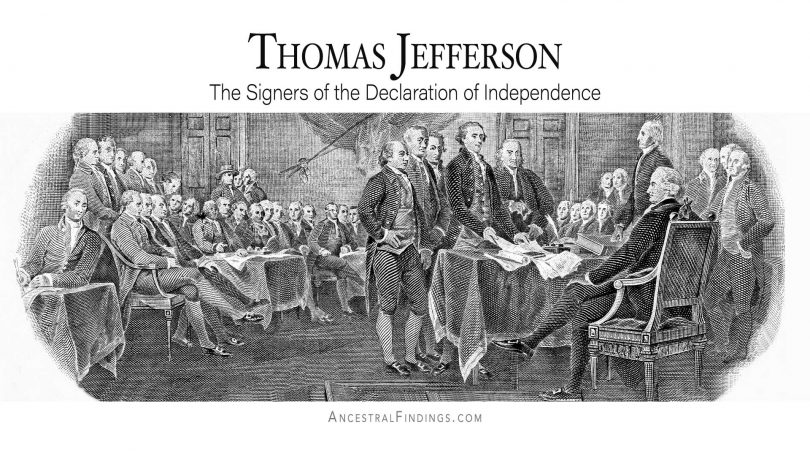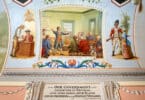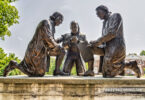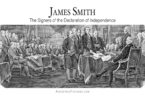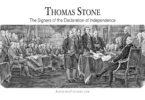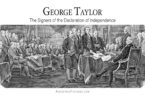One of the most famous signers of the Declaration of Independence is also the person who was largely responsible for writing it. This person, of course, is Thomas Jefferson. Most people know he wrote the original draft of the Declaration of Independence (which was later edited by a committee at the Continental Congress, before the Congress voted to adopt it), and that he was the third President of the United States. Not as many people know how accomplished he was in a wide variety of areas. He was a farmer, lawyer, politician, statesman, diplomat, inventor, musician, architect, and more. While the vast majority of his life story is already well-known, as he is one of the most famous of the Founding Fathers, there are some highlights that we can go over here to help you get to know this remarkable man a little better.
Thomas Jefferson was born on April 13, 1743, at his family’s Shadwell Plantation in Virginia. Thomas was the third of ten children born to his parents, Peter Jefferson and Jane Randolph. Thomas’s father was a planter and a surveyor and died when Thomas was just fourteen years old. Thomas and his brother Randolph each inherited half of their father’s estate. Thomas’s share included about five thousand acres of land, which included the site where he would build his home, Monticello. He took full control over his inheritance when he turned twenty-one.
Because Thomas’s father was self-taught, he was keen that his children have good formal educations. Thomas’s was an exceptional education, which is why he became so proficient and interested in so many things. There were few areas of scholasticism where Thomas did not at least dabble. While he was highly accomplished in his education and had a good career as a lawyer already begun as a young man, as well as having already started building Monticello at a young age, he was rather shy and had a difficult time talking to women. After at least one instance of unrequited love, where the object of his affection married someone else, Thomas finally found the woman for him.
On January 1, 1772, Thomas married Martha Wayles, the twenty-three-year-old widow of Bathurst Skelton, by whom she had one young son. Martha moved into Monticello, though it was still unfinished (and Thomas would, in fact, continue working on Monticello for most of the rest of his life), and became a hostess for guests and the household manager there. She and Thomas had six children together, five daughters and a son, though only two daughters survived past childhood (her young son by her first husband also passed away during early childhood).
Thomas and Martha were married for ten years, and Thomas seems to have regarded this period of his life as the happiest one. When they were together, Martha would play the piano while Thomas accompanied her on the violin or cello. Martha was also an enthusiastic reader and did excellent fine needlework. Yet, her frequent pregnancies weakened Martha and having to flee British soldiers who wanted to capture Thomas (who was Governor of Virginia at the time) just after giving birth to her fifth child did not help matters. She also suffered from diabetes. Her own mother had died young, and Martha had to endure two unpleasant step-mothers as a child. When she knew she was dying, she made Thomas promise to never remarry, as she did not want her children being raised by another woman. He kept this promise.
When Martha passed away on September 6, 1782, Thomas was with her. He was almost mad with grief for weeks afterward, locking himself in his room, and burning the letters they had written to each other. He did keep a lock of her hair as a souvenir. After he finally came out of his room, he went on long walks in the country, accompanied by his eldest daughter, Martha. This daughter later wrote that on these walks, she was often a “solitary witness to many a violent burst of grief” by Thomas. Eventually, he left the new United States altogether for a while, becoming an ambassador to France, taking Martha with him, and leaving his two younger daughters, Maria and Lucy, at home. Lucy died at three years old while Thomas was away, and at that point, he sent for Maria, who came to France with her maid and companion, Sally Hemmings. Sally is often thought to have been a half-sister to Thomas’s wife, and definitely was a slave he inherited from his father-in-law.
While Thomas’s political activities are well-known, and his presence at the second Continental Congress during his marriage to Martha, where he wrote the Declaration of Independence, is a celebrated historical fact, these activities were just a small part of all of the things he accomplished during his life. While he primarily considered himself a planter and lawyer (and later, a politician), he also knew how to survey land, was a keen mathematician, a skilled horticulturalists, and a capable mechanic. He was a self-taught architect in the classical tradition. He had a strong interest in religion and philosophy and was at one point president of the American Philosophical Society. He was not part of organized religion but had his own personal religious beliefs that were influenced by both Christianity and deism. He spoke and/or read several languages. He was an author of several books, including Notes on the State of Virginia (published in 1785, and considered the most important American-published book written before 1800). He was a proponent of the ideals of the Enlightenment. In addition, Thomas was a letter writer, and there are thousands of pages of his correspondence preserved today. Among the people, he regularly wrote to were some of the most powerful world leaders of his time.
After he finally retired from public office—something he tried to do more than once, but the leaders of the United States kept calling him back to public service—he spent his leisure time doing such things as founding the University of Virginia. While he took great joy in the role of grandfather and could be found by statesmen and world leaders alike playing with his many grandchildren on the floor of his home when they came to visit, he was by no means idle. Thomas stayed engaged in both public and private life all of his life.
In one of the most interesting coincidences in history (or, maybe, it was the intervention of a higher power), Thomas Jefferson and his compatriot at the Constitutional Convention, the second President of the United States, John Adams, both died on July 4, 1826, just a few hours apart from one another. It was the fiftieth anniversary of the Signing of the Declaration of Independence. Thomas was buried in the Jefferson family cemetery at Monticello, beside his beloved Martha. Members of the Jefferson family are still permitted to be buried there today.
These descendants have always included the descendants of Thomas’s two surviving daughters, Martha and Maria, and the right to use the cemetery has also recently been opened up to the descendants of Sally Hemmings, whose family oral history (and, more recently, DNA) says had at least six children who were fathered by Thomas. While Thomas’s slave-owning history makes him controversial among some people, he is still today regarded among most of the American people as one of the top ten American presidents.

